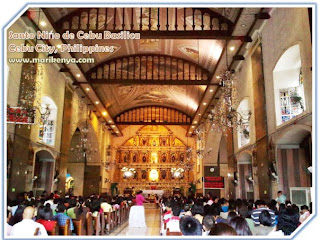The Santo Niño de Cebú ("Holy Child of Cebu") is a Roman Catholic figure of the Child Jesus highly similar to the Infant Jesus of Prague. Like the image's counterpart in Prague, the figure is clothed in expensive textile robes mostly donations from fervent devotees in the Philippines and abroad. The statue is the oldest Catholic relic in the Philippines and permanently housed since 1565 at the Basilica Minore del Santo Niño in Cebu City.
In April 1521, Portuguese explorer Ferdinand Magellan, in the service of Charles I of Spain, arrived in Cebu during his voyage to find a westward route to the Indies. He persuaded Rajah Humabon and his wife Humamay, to pledge their allegiance with Spain. They were later baptized into the Catholic faith, taking the Christian names Carlos and Juana. Magellan presented the Santo Niño to the newly-baptized Queen Juana as a symbol of the alliance. To her husband Carlos, Magellan presented the bust of the "Ecce Homo", or the depiction of Christ before Pontius Pilate. He gave an image of Our Lady to the natives who were later baptized with their rulers. However, Magellan died later on April 27, 1521 in the battle that took place in Mactan, , leaving the image behind. In its new environment, among sun-loving people, the image stopped to be a Christian symbol. After some vain efforts on the part of the natives to destroy it, as legends say, it endured its new setting and prevailed to become a pagan idol. The Cebuano natives revered the Image of Santo Niño as Bathala. They most probably blessed the image with oil or offered sacrifices to the Santo Niño while invoking for His assistance in times of difficulties, reliefs in their necessities or consolations in their adversities.
The Basilica Minore del Santo Niño built on the very same spot where the image was found on April 28, 1565, housed the statuette of the Santo Niño. Originally made out of bamboo and mangrove palm, the Santo Niño Church developed into a fortress where ardent devotees from all walks converge for thanksgiving or supplication to the Child Jesus, whom they have venerated through the centuries. With the increasing number of devotees flocking the Church of Santo Niño, Pope Paul VI elevated its rank as minor basilica with all rights and privileges accruing to such conferment for the Quadricentennial celebration of Christianity in the Philippines.
Numerous miracles have been wrought by the power of the Santo Niño. It is said that a voluminous book is needed to contain all the attestations and testimonials of the goodness and mercy of the Infant Jesus of Cebu. Considered as the prime of all Christian relics in the Philippines, the image of the Infant Jesus continues to shine as the lodestar that attracts the hearts of the Filipino people.
Meanwhile, the Visayans continue to manifest affection with the Santo Niño, who, not only during his feast day, but all year round have come to pay homage to a Gift, so simple yet profound.
FEAST OF SR.STO NiñO
The Fiesta Señor celebration starts on the Thursday after the Solemnity of the Epiphany. Each year, the celebration starts with a procession called the Walk with Jesus and ends with the Walk with Mary, wherein the image of Nuestra Señora de Guadalupe de Cebu, in full regalia, is carried in procession on the streets of Cebu at dawn. On the last day of the novena, the images of Señor Santo Niño de Cebu, Nuestra Señora de Guadalupe de Cebu, and the Ecce Homo, is motorcaded to the National Shrine of Saint Joseph in Mandaue City for the traditional "traslacion", which means 'to transfer'. The images shall then be sent back to the Basilica on the eve of the feast of Señor Santo Niño de Cebu through a well-attended fluvial procession at Mactan Channel. Upon arrival at the Basilica, a high mass commemorating the first baptism shall take place. After which a long grand solemn foot procession, usually attended by more than a million devotees of the Santo Niño starts in a route that changes every year.
Pontifical masses, officiated mostly by Cebuano bishops are celebrated during the feast proper. The Holy SeeFeast of the Santo Niño in the Philippines, set on the third Sunday of January. The festival that follows is known as the Sinulog, which combines the festivities and religious devotion of the Cebuano people. approved special liturgical texts for use during the local
DEVOTES OF SR.STO NiñO
The devotion to the Santo Niño de Cebu started the long line of devotions to the Child Jesus in the Philippines. From Cebu, the Augustinians brought the devotion to Manila, Iloilo, Laguna and Tacloban. In Bohol, a profound devotion thrives with five municipalities adhering to the patronage of the Child Jesus. Moreover, the image of the Child Jesus always adorn the altars of houses, business establishments and even in public utility vehicles in the region. Truly as it has been said, devotion to the Santo Niño de Cebu is popular in the Visayas as it is throughout the country.
BASILICA MINOR DEL STO.NiñO
This church was built by Miguel Lopez de Legaspi and Fr. Andres Urdaneta on the site where the image of Santo Niño was found in 1565. The first structure of the church was, however, destroyed by fire on November 1, 1568. It was rebuilt in 1602 under the administration of Juan Albaran and was rehabilitated in 1740. On May 1965, the church was conferred the title of Basilica Minor del Santo Niño Antonuitte, Papal Legate during the Fourth Centennial celebration of the Christianization of Cebu.










